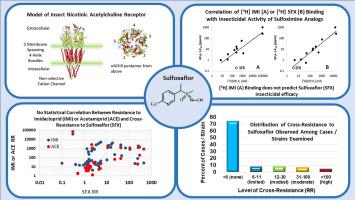Pesticide Biochemistry and Physiology ( IF 4.2 ) Pub Date : 2021-07-15 , DOI: 10.1016/j.pestbp.2021.104924 Gerald B Watson 1 , Melissa W Siebert 1 , Nick X Wang 1 , Michael R Loso 1 , Thomas C Sparks 1

|
The sulfoximines, as exemplified by sulfoxaflor (Isoclast™active), are a relatively new class of nicotinic acetylcholine receptor (nAChR) competitive modulator (Insecticide Resistance Action Committee [IRAC] Group 4C) insecticides that provide control of a wide range of sap-feeding insect pests. The sulfoximine chemistry and sulfoxaflor exhibits distinct interactions with metabolic enzymes and nAChRs compared to other IRAC Group 4 insecticides such as the neonicotinoids (Group 4A). These distinctions translate to notable differences in the frequency and degree of cross-resistance between sulfoxaflor and other insecticides. Most insect strains exhibiting resistance to a variety of insecticides, including neonicotinoids, exhibited little to no cross-resistance to sulfoxaflor. To date, only two laboratory-based studies involving four strains (Koo et al. 2014, Chen et al. 2017) have observed substantial cross-resistance (>100 fold) to sulfoxaflor in neonicotinoid resistant insects. Where higher levels of cross-resistance to sulfoxaflor are observed the magnitude of that resistance is far less than that of the selecting neonicotinoid. Importantly, there is no correlation between presence of resistance to neonicotinoids (i.e., imidacloprid, acetamiprid) and cross-resistance to sulfoxaflor. This phenomenon is consistent with and can be attributed to the unique and differentiated chemical class represented by sulfoxalfor. Recent studies have demonstrated that high levels of resistance (resistance ratio = 124–366) to sulfoxaflor can be selected for in the laboratory which thus far appear to be associated with enhanced metabolism by specific cytochrome P450s, although other resistance mechanisms have not yet been excluded. One hypothesis is that sulfoxaflor selects for and is susceptible to a subset of P450s with different substrate specificity. A range of chemoinformatic, molecular modeling, metabolism and target-site studies have been published. These studies point to distinctions in the chemistry of sulfoxaflor, and its metabolism by enzymes associated with resistance to other insecticides, as well as its interaction with insect nicotinic acetylcholine receptors, further supporting the subgrouping of sulfoxaflor (Group 4C) separate from that of other Group 4 insecticides. Herein is an expansion of an earlier review (Sparks et al. 2013), providing an update that considers prior and current studies focused on the mode of action of sulfoxaflor, along with an analysis of the presently available resistance / cross-resistance studies, and implications and recommendations regarding resistance management.
中文翻译:

Sulfoxaflor – 一种亚砜亚胺杀虫剂:作用方式、抗性和交叉抗性的回顾和分析
以 sulfoxaflor (Isoclast™active) 为例,亚砜亚胺是一类相对较新的烟碱乙酰胆碱受体 (nAChR) 竞争性调节剂(杀虫剂抗性行动委员会 [IRAC] 4C 组)杀虫剂,可控制各种树液喂养害虫。与其他 IRAC 第 4 组杀虫剂(例如新烟碱类(第 4A 组))相比,亚砜亚胺化学和氟虫腈与代谢酶和 nAChR 表现出明显的相互作用。这些区别转化为氟啶虫胺与其他杀虫剂之间交叉抗性的频率和程度的显着差异。大多数对多种杀虫剂(包括新烟碱类)表现出抗性的昆虫品系对氟啶虫胺几乎没有交叉抗性。迄今为止,只有两项涉及四种菌株的基于实验室的研究(Koo 等人,2014 年,Chen 等人,2017 年)在新烟碱类抗性昆虫中观察到对氟啶虫胺酯的大量交叉抗性(> 100 倍)。如果观察到对氟啶虫胺具有较高水平的交叉抗性,则该抗性的程度远小于选择的新烟碱类药物的抗性程度。重要的是,对新烟碱类(即吡虫啉、啶虫脒)的耐药性与对嘧菌酯的交叉耐药性之间没有相关性。这种现象与以磺草胺为代表的独特和差异化的化学类别一致,并可归因于。最近的研究表明,可以在实验室中选择对氟虫腈的高水平抗性(抗性比 = 124–366),迄今为止,这似乎与特定细胞色素 P450 的代谢增强有关,尽管尚未排除其他抗性机制. 一种假设是,氟啶虫胺选择并易受具有不同底物特异性的 P450 子集的影响。一系列化学信息学、分子建模、代谢和靶位点研究已经发表。这些研究指出了氟啶虫胺的化学性质、与其他杀虫剂抗性相关的酶的代谢以及它与昆虫烟碱乙酰胆碱受体的相互作用的区别,进一步支持将氟啶虫胺(4C 组)与其他第 4 组杀虫剂的亚组分开。这里是对早期综述(Sparks 等人,2013 年)的扩展,提供了一个更新,考虑了以前和当前关注氟啶虫胺作用模式的研究,以及对目前可用的抗药性/交叉抗药性研究的分析,以及关于耐药性管理的影响和建议。











































 京公网安备 11010802027423号
京公网安备 11010802027423号